-
Notifications
You must be signed in to change notification settings - Fork 3
Pied Piper Updates
The initial results of the digital filter are very promising towards eliminating noise outside the target spectrum of 100-250 Hz for the system's detection algorithm. The filter was tested on White Gaussian Noise, the male treehopper mating call, and the male treehopper mating call with additive white gaussian noise. The images below show the original time and frequency domain plots of the input signal and the filtered output signal.
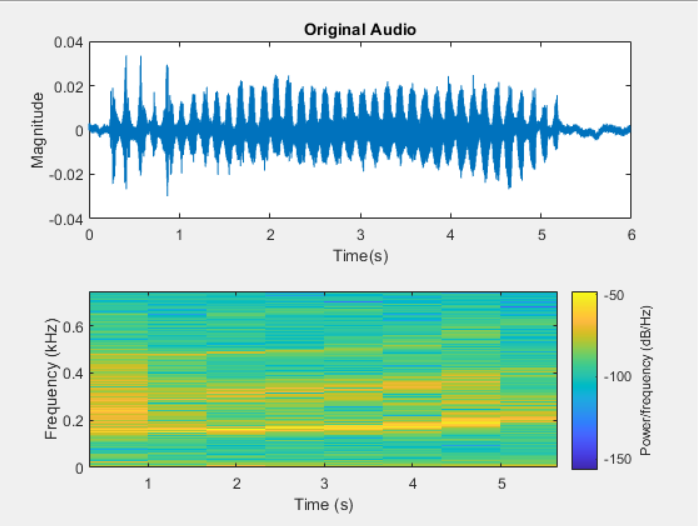
A 1st order butterworth bandpass filter is in the process of being tested for its efficacy at removing high frequency and electrical noise from the input to the system. The filter will be tested against a variety of signals including pure white noise, the male treehopper mating call, and the male mating call with added noise. The magnitude and frequency plots will be compared to determine the effectiveness of the filter at removing excess noise from the incoming signal
Elijah Shumway
A spectrogram tool (and a corresponding new operating mode) has been developed for plotting live audio data from a Pied Piper unit. The tool can be used to visualize how digital processing affects the incoming signal, and to help with calibrating settings on the audio conditioning IC.
Example of audio spectrum data:
The tool is implemented in Python, and it is run on a computer connected via serial COM port to a Pied Piper unit. The unit must be put into the LiveSpectrogram operating mode in order to begin streaming data, which is achieved by setting the board's DIP switches to [1 0 0]. Both raw audio samples and audio spectrum data can be displayed.
Vincent Vaughn
New power modes have been implemented into the SAMD51 architecture of the FeatherM4. Currently supported for Pied Piper are the OFF, HIBERNATE, and BACKUP modes. There are still issues with the Watchdog timer in the IDLE mode that cause the board to wake immediately. The Hypnos board will soon be integrated to wake the Pied Piper system after a set amount of time, drastically improving the power draw of the system.
Elijah Shumway
In order to facilitate testing without access to live insects, two new methods have been developed. The first generates a replica of the male mating call with a user controlled signal to noise ratio(SNR). This will allow the team to test the response of the system under controlled noisy situations, allowing us to judge the minimum SNR required for a successful detection. The second is a tool that allows for live spectrogram readings of an incoming signal into the Pied Piper system. This will allow the team to visualize any incoming signal in the frequency domain, furthering the effectiveness of detection and the ability to adjust the audio conditioning IC parameters.
Elijah Shumway
A new version of the detection algorithm is in the process of development and testing. This new algorithm detects the time distance between peaks instead of the number of peaks per second to eliminate false positives caused by high frequency noise. Additionally, a digital low pass filter is being considered to eliminate magnitudes at high frequencies to focus the detection algorithm only on the frequency band of the Treehoppers. Further updates of the effectiveness of this algorithm vs the original will be posted as development and testing continues
Elijah Shumway
After the second round of field testing, the collected data was analyzed. This data showed a large quantity of false positives that had not showed up in lab testing. Most of these false positives can be attributed to high frequency peaks in amplitude from noise on the vine that tripped the peak detection component of the detection algorithm. This discovery has led to the detection algorithm to be reanalyzed for efficacy. The peak detection algorithm is being refined to calculate the time difference between peaks instead of counting the number of peaks in a set time period to attempt to remove these false positives
Elijah Shumway
Second round of testing is currently being conducted to address some of the issues identified in the initial field testing. Additionally, battery capacity will be measured to determine project lifetime.
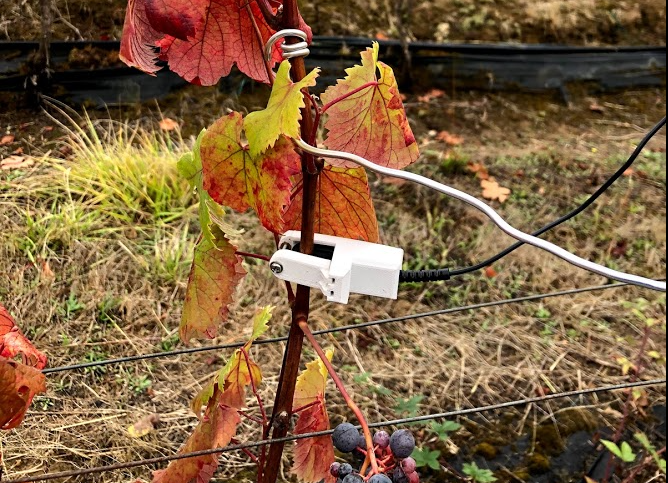
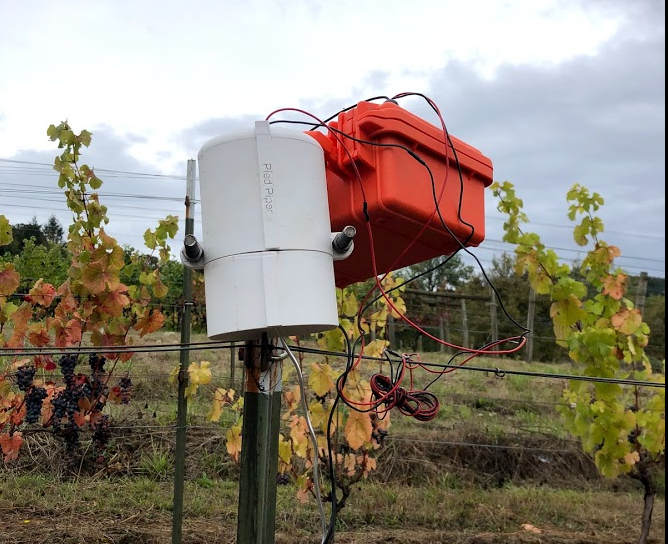
Elijah Shumway
Two Pied Piper systems were placed out for field testing at Stag Hollow Vineyards. During this phase of testing, the Pied Piper was left in full detection mode to attempt to determine the presence of and attract treehoppers from the grape vines. One system was attached directly to a vine on the vineyard, while another was attached to a crab apple tree directly adjacent to the property
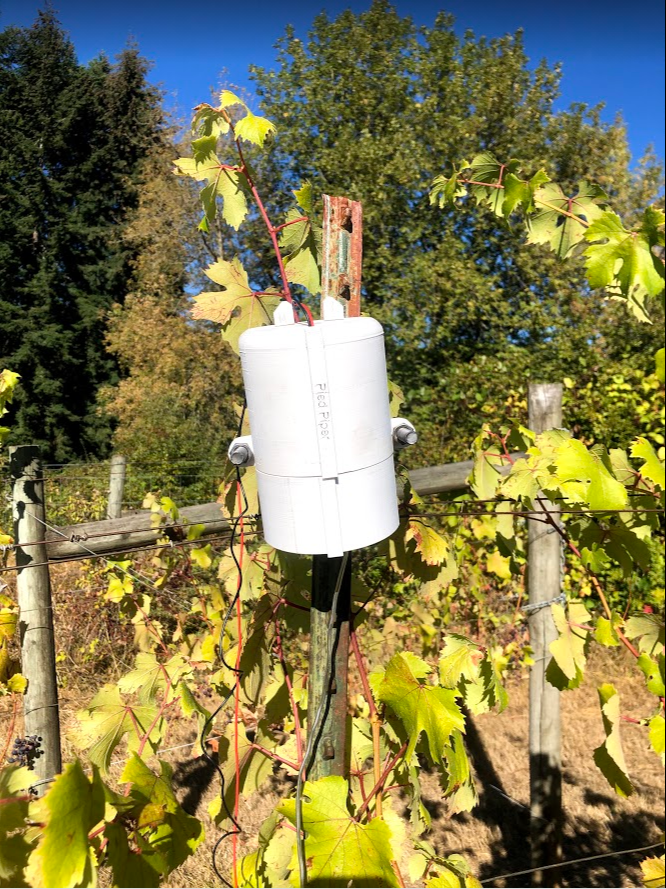

Elijah Shumway
In order to prepare for field testing the ability to record was implemented onto the Pied Piper system. During detection, a half second recording is generated by sampling incoming values from the contact microphone. When an insect is detected, this recording is saved to the built in SD card to be processed and analyzed later
Elijah Shumway
A new PCB for the Pied Piper has been designed and is in the process of being manufactured. The new board includes breakouts for the individual potentiometers that control the audio conditioner allowing for ease of access with the user. Additionally, a DIP switch has been added to control different modes of the system. Finally, the board has been designed to run off of a single 12 volt power supply to reduce the number of external connections needed.

Elijah Shumway
The new vibration exciter and trap were tested, and the exciter can easily propagate signals further than one meter through a substrate. Additionally, the Pied Piper system was able to successfully detect a simulated male mating call from over a meter away and triggered the female mating call for playback.
Elijah Shumway
The trap for the Pied Piper has been modeled and printed and is now ready for use. Construction of the full Pied Piper system is underway and is on its way to be ready for full system testing by the following week.
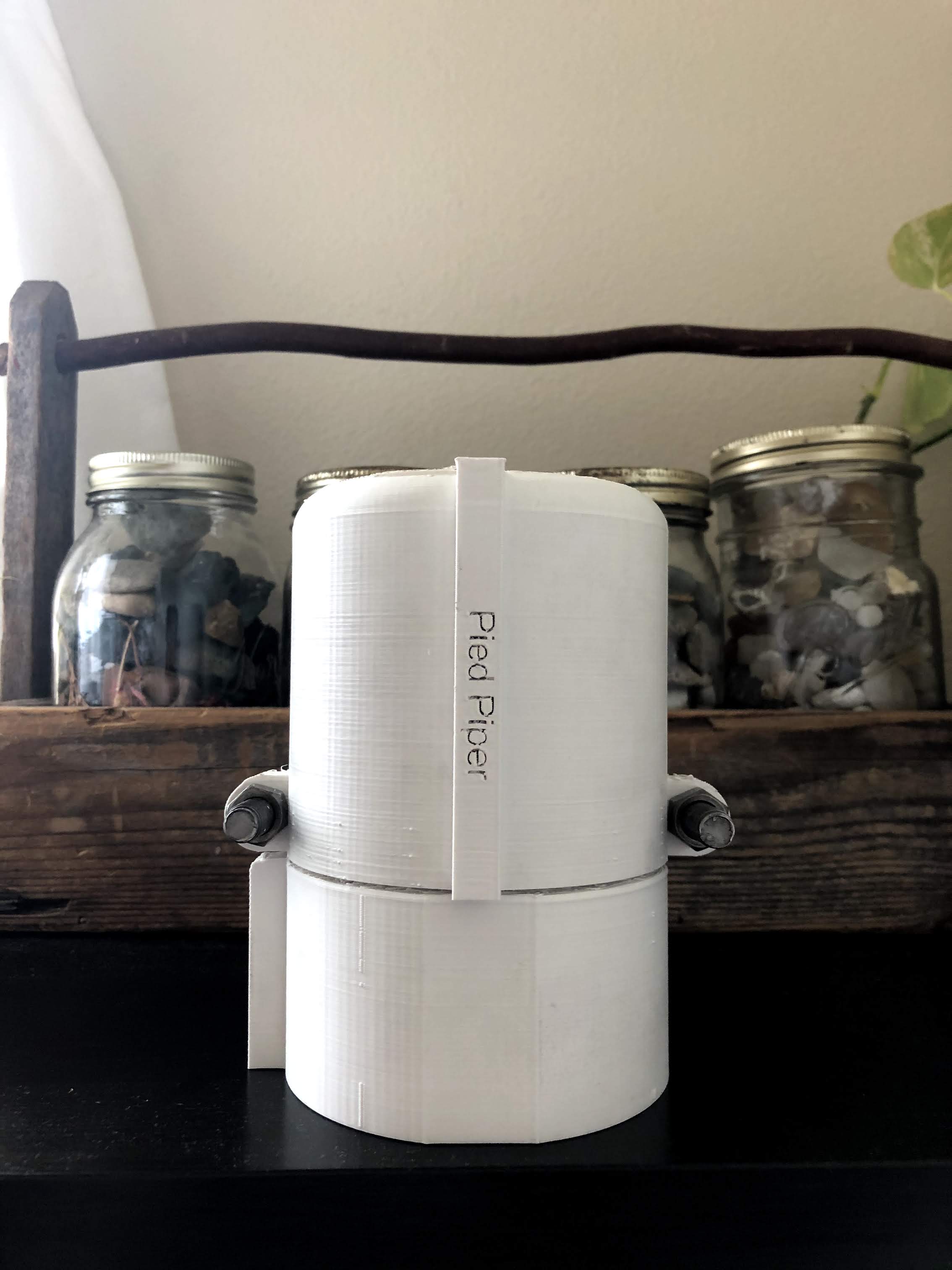


Elijah Shumway
The previous LRA used for vibration excitement has been traded out for a 30 mm Dayton audio exciter. This audio exciter is much stronger and can propagate the mimic signal much farther through the substrate. Additionally, the trap for the system is in the process of being 3D modeled.
Elijah Shumway
A new contact mic housing has been designed to provide a stronger connection between the contact microphone and the substrate. Once printed, this new enclosure will be tested to determine the accuracy of the system.

Elijah Shumway
After successful initial tests with insect detection, further testing was performed to determine the accuracy of the system. In these tests, a linear resonant actuator(LRA) was used to simulate an insect. The LRA was tuned against previous recordings using a laser vibrometer to ensure the LRA was producing the same amplitude and frequency spectrum of the insect in question. After tuning to the correct parameters, the Pied Piper system was attached to the substrate to test its accuracy in recognizing the insect at various distances from the LRA. At each distance the system was tested against 6 repetitions of the insects mating call, and the number of successful detections were counted. After testing, it was determined that the Pied Piper system can detect the male mating call with 86.67% accuracy up to a distance of 25 cm. Further testing is planned to determine accuracy at longer distances and to gain insight into the overall accuracy of the system
Elijah Shumway
Redesigned the PCB to use an LM386 audio amplifier instead of the MAX9744. This switch cut the size of the PCB approximately in half, and will decrease the power required the run the system in playback mode. An attached gain and volume control will allow the board to be tuned to match the amplitude of the physical insect.
Elijah Shumway
Discovered an issue in the code that caused the shift register to behave strangely. The TPIC6B595 is now able to correctly turn on different inputs to the Audio FX board, allowing for a maximum of 8 different audio files to be played. Additionally, all of the Audio pins are now mapped to their respective inputs from the control board i.e. sending a 1 to the shift register will cause Audio pin 1 to play.
Elijah Shumway
Improved the frequency checking portion of the insect detection algorithm. The code now more effectively measures the ending frequency of the mating call to the initial frequency. This makes the algorithm more accurate and has lowered the amount of false positives generated.
Elijah Shumway
Discovered a bug in the code that was causing false positives when running detection. Fixed the bug and adjusted detection parameters to be more effective at only detecting the insect in question
Elijah Shumway
After the implementation of the SSM2166 audio conditioner IC, the sensitivity of the contact mic was greatly increased, allowing for the detection of extremely quiet sources of vibrations. This increased sensitivity allowed the system to be able to accurately detect the insect's mating call created through a vibration motor. Further testing needs to be conducted in order to increase the accuracy and efficiency of the system towards detecting insects, but it has been successful in detecting an insect mating call through a substrate.
Elijah Shumway
A component to better connect the contact mic to a substrate has been modeled and printed. This component will allow the user to attach a contact mic securely to various widths of substrates and more effectively measure vibrations across the substrate.
Elijah Shumway
The Pied Piper has gone from components on a bread board, to a condensed PCB that houses all of the hardware for the system. An audio input conditioner IC with an integrated amplifier has been installed on the PCB in order to increase the clarity of any incoming vibrations, hopefully allowing the Pied Piper to more effectively recognize insects on a substrate. Additionally, 3D printed parts to house the vibration motor and the contact mics have been modeled and printed. These parts allow for a solid contact between the components and the substrate, allowing for a stronger signal to be detected through the substrate.
Elijah Shumway
The vibration motor enclosure has been modeled and printed. This piece allows for solid contact between the vibration motor and the substrate, allowing for a stronger signal to be applied to the substrate

Elijah Shumway
The custom PCB for housing the Pied Piper microcontrollers and ICs has been designed and ordered. Further testing into improving the system's sensitivity will be conducted on the PCB's arrival
Elijah Shumway
The detection algorithm can now detect the presence of insects in half the time as before, with no loss of accuracy
Elijah Shumway
- Project Planning
- Prototyping
- Synthesis
- Lab Testing
- Field Testing
- Finalization/Production
- Poster/Presentation
- Publication
- CRES
- Dendrometer
- Djinn
- eDNA Sampler
- eGreenhouse
- Evaporometer
- FloDar
- HyperRail
- Hypnos
- Isotopic Sampler
- Lilypad
- Loom
- Micro-Aggregating Sewer Sampler
- Mooraca
- OPEnSampler
- Pied Piper
- Rag Guard
- Rain Gauge Calibrator
- RainSavor
- RFID Moisture
- Sap Flow Meter
- SitkaNet
- Slide Sentinel
- Smart Rock
- Spool
- WeatherChimes
- Weed Warden
- Wisp
- Archived Project Blogs
